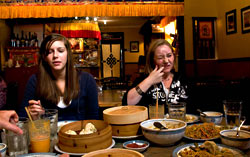Something about Tibet First in the U District reminded me of a guesthouse half a continent away, a tiny hostel in Bangkok where I sweated away a few days last March en route to Hanoi. It wasn’t the red-and-gold silk banners framing the doorways, or the jewelry cases and racks of prism-hued clothing for sale. It wasn’t the New Age, Asian-fusion electropop coming from the speakers, though I’d heard a lot in Thailand, too. I scanned the room a few times, looking for the connection, before it clicked: white kids with dreads.
It’s hard to think of a nation more appealing to the imagination of liberal, high-minded Seattle travelers than Tibet: An achingly remote landscape. An intellectual, aesthetically compelling religious tradition. A people threatened with the cultural equivalent of being paved over.
Three-month-old Tibet First does cater to the curious. Owners Jampa and Didi Jorkhang, who moved here a year ago after running a similar restaurant in Minneapolis, picked a spot at backpacker central: blocks from the UW campus, situated between a vegan cafe and broken-down student homes. But the tiny converted house is one of the few places in Seattle where the prayer flags wrapping the porch actually mean something, where the Dalai Lama portrait hanging behind the cash register is a symbol of devotion and identity, not just peaceful thoughts. The seekers are joined by tables of Tibetan Americans, cupping mugs of frothy buttered tea and covering their tables with steamers of momo.
As for me, once I dispelled a few of my own vague, traveler-type fantasies of Tibet First, I enjoyed a number of the restaurant’s dishes. Are the flavors true to tradition? Not exactly. The cooks import their spices from Nepal and India, but yak milk and meat is hard to come by in the States, and the restaurant makes other concessions to American tastes (less dried mutton, more green vegetables). Tibet First doesn’t even serve tsampa, the Tibetan staple—a dough of roasted barley flour mixed with tea and yak butter and eaten straight. Ultimately it’s impossible to divine the line between authenticity and assimilation in any of the food.
Looking over the menu, though, two things are clear: Tibet is smooshed between China and India. Also, mile-high deserts are hard places to grow food.
My first meal, for example, started with shoko khatsa: potato coins spiked with enough curry powder to tint them pale yellow, then pan-fried slowly—so they softened without falling apart—with green onions and sliced green chiles. The potatoes segued into a bamboo steamer of momo, Tibet’s other national dish.
Momo are steamed dumplings, some half-moons and some round buns. The chicken momo I tried on the first visit were indistinguishable from good-quality chicken pot stickers, except instead of soy sauce and chili paste, the dumplings came with a spiced mung bean and split-pea soup, along with a spicy puree of fresh tomatoes and peppers. On my second visit, my friends and I went out on a limb and ordered the peanut butter momo, stuffed with a mix of ground peanuts and mashed potatoes—palatable, but nothing I’d ever order again. I asked Jampa whether peanut butter momo were common. “Well, no,” he admitted. “It’s an Americanization we came up with in Minneapolis.” What are momo usually filled with in Tibet? Yak, of course. (Beef would be the closest substitute.)
It also became clear that mountain food isn’t quite as compelling as it sounds, at least when you’re not actually trekking across a mountain. A beef curry was cooked with al-dente potatoes and stew beef heated up until the meat was just cooked through, not tender (I gave up on it after gnawing my way through one stringy chunk). The vegetarian bhagthup looked promising, but the dish turned out to be exactly what the menu said it was, and not an iota of flavor more: firm, gnocchi-like dumplings floating in a weak vegetarian broth along with tofu, radish slices, and spinach. Starch-legume combinations seem to be a common theme, carbolicious food that will get you to the end of the trail but isn’t going to win any “Hot New Cuisine” contests. I also confirmed that bhocha, hot black tea frothed with salted yak butter, tastes just like it sounds, and just as I remembered from my last attempt to drink it—best described as a cultural experience. I rinsed with water and then stole sips of my guests’ mango-yogurt shake.
But on the second visit, I discovered that anticlimactically hearty fare isn’t the extent of Tibetan cuisine, either. Once I’d recovered from the peanut butter momo, I alternated bites of sha bhalay—a fist-sized pastry crescent stuffed with savory ground pork and scallions—with a sharp, cilantro-perfumed salad of shredded daikon, carrot, onion, and tomato. I used wedges of bhaglab—a thick, soft round of bread whose edges were crisped in a wok—to scoop up the curried split-pea soup left over from the momo. And I swirled pieces of tingmo (a puffy steamed bread served in coils) through the tema tsel (a bowl of chickpeas and potatoes stewed in a veggie broth thick with spice and heat, cut with fresh cilantro). The tingmo was certainly no tsampa, but I wasn’t sure I minded.






